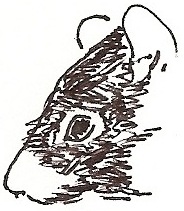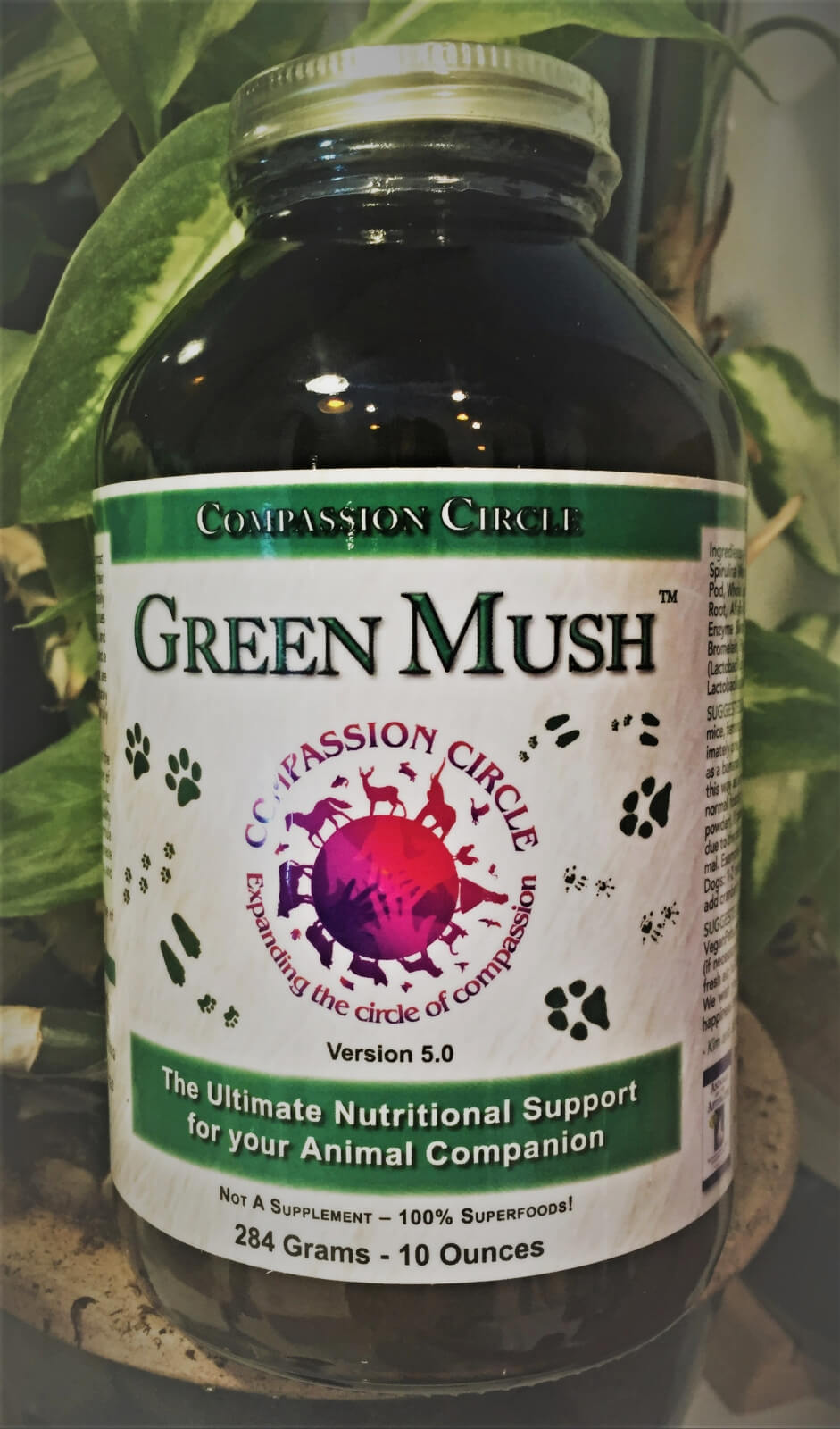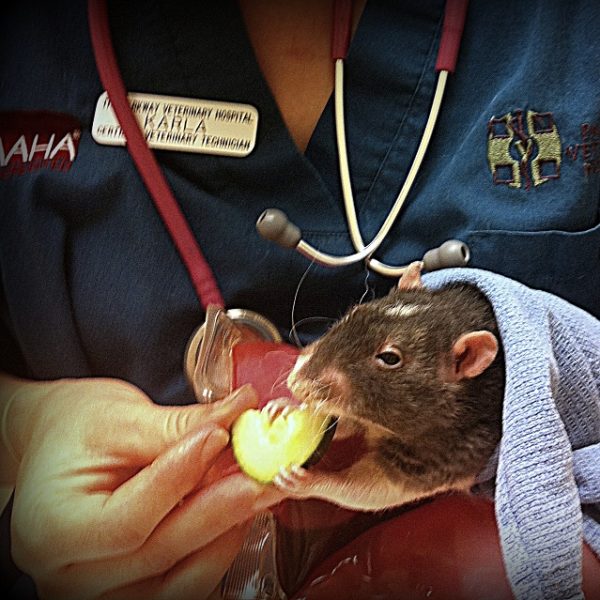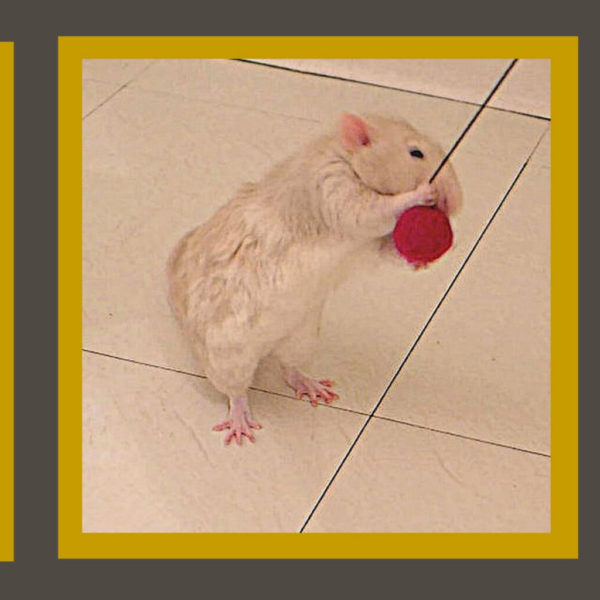Green Mush
From my personal experience, an essential pet rat supplement is Green Mush. Ever since I began feeding my rats Green Mush they’ve lived much longer lives. My first rat, a male, only lived to be 1 ¾ years. After I began feeding Green Mush to my pet rats, my males began living as long as 3 ¼ years. Keep in mind females will live even longer.
Green Mush was created by the founders of Healthforce Nutritionals specifically to provide the highest quality, most comprehensive nutrition for their pet rat, June!
Fish Oil
A high-quality fish oil or source of EPA/DHA is beneficial for pet rats. Fish oil helps reduce inflammation, loosens up stiff joints, enhances skin quality and can make a rat’s coat softer and shinier. It can also support immune health, improve allergies, and help with cardiovascular function.
I’ve been using Nordic Naturals Omega-3 which has been approved by my rats’ veterinarian. Check with your rats’ veterinarian to determine if fish oil would be helpful for your rats. Your veterinarian will let you know what dosage is best for each of your rats. (The dosage will vary based on their weight. For example, my rats are receiving 0.25ml daily.)
Probiotic
Another pet rat supplement that’s worthwhile is a probiotic. It helps maintain healthy intestinal flora. Specific strains of probiotics can lessen any damage caused by antibiotics prescribed for your rats. They also can help fight pathogenic bacteria and promote a good immune response. Recent studies have shown a probiotic supplement may even fight an antibiotic-resistant infection.
Whatever the reason you choose to give your rats a probiotic, consult with your veterinarian first. Your veterinarian can let you know if they believe a probiotic is advantageous for your rats, which type to get and the dosage for each rat.
Vitamin B Complex
Vitamin B supplementation for male rats can help reduce symptoms of hind leg degeneration which occurs in some older rats. Some people believe it can even reverse the symptoms. This is controversial—-not all vets believe Vitamin B can relieve spinal nerve root degeneration. I’d rather just give it to my male rats even if it may not help hind end paralysis. It is not considered harmful so why not?
My all-time favorite rat veterinarian recommends giving one drop daily for two weeks and then transitioning to every other day. Some rats are fine with one drop 2-3 times a week if they are on a well-balanced diet. You can either mix the drops with food or just give them orally. Most rats don’t find them particularly delicious, so mixing them with food is usually best.
It’s important to check with your rats’ vet to find out what they think and to learn what dosage they recommend for your rat(s). One of my current veterinarians has told me to wait until my newest male rat is 1 year old before supplementing.
The brand my veterinarian recommends is Nature’s Bounty Vitamin B Complex Sublingual Liquid. (This supplement is currently only available as a 2-pack.)

Chromium Picolinate
I have read mixed reviews on using chromium picolinate as a pet rat supplement. Debbie Ducommon advocates using it to help increase longevity. A veterinarian I highly revere also recommends using it. Because I’ve heard both pros and cons regarding the effectiveness of adding chromium picolinate to a rat’s diet, I am currently choosing not to use it for my rats.
Years ago, I tried giving my rats chromium picolinate. I gave it to two males who, until adding the chromium, had been very close and enjoyed each other’s company tremendously. However, after one week on the chromium, one of the boys severely “beat up” the other resulting in a trip to an emergency hospital as well as needing to keep them separate. I realize my experience is purely anecdotal and may also be coincidental.
updated 11/28/23








Were you paid by Green mush to advertise? The way to respond to everyone with a link and a pitch is giving that impression. That’s fine if you are I would like a confirmation if that is the case :)
Hi Poppy,
Thanks for your thoughtful question. I’m not paid by Green Mush—or any other company—to advertise their products. However, I do participate in affiliate programs for many of the items I recommend on my site. This means I may earn a small commission if someone makes a purchase through one of my links, at no additional cost to them.
Transparency is important to me, and I include an Affiliate Disclosure on my website to explain this in more detail. I only recommend products I believe in and have either used personally or thoroughly researched for the benefit of pet rats and their caretakers.
Please don’t hesitate to reach out if you have any other questions!
Best,
Jasmine | About Pet Rats
I was curious about US supplements for Vitamin D and calcium? I’ve seen the all the Uk versions and am not sure about what brands they carry here that are good for them. I did just order the Green mush thanks to you and i can’t wait to give my boys some! Thanks!
Hi Kelsey,
I’m so excited for you and your rats—-they’re going to love Green Mush and you’ll love the health-boosting benefits.
Regarding Vitamin D and Calcium, are you looking to give these particular vitamins to your rats? To my knowledge, there’s no need to supplement pet rats with Vitamin D and Calcium. If you’re feeding them a high quality commercial diet, they’re already getting enough Vitamin D and Calcium.
Let me know if I’m misunderstanding your question and/or whether you have any further questions.
Enjoy the Green Mush!
Jasmine | About Pet Rats
Hello! I have a question about heating a rat cage. My basement office gets quite chilly (58-59 degrees) and I gave placed a heating pad under the cage and it has a programmable thermostat that shuts off when it reached 75 and turns off when it goes below 65. The probe is dituated on the bottom as well away from where they can get to it and chew on the wire. It is currently reading 64.5 F. They also have hiding places with lots of bedding. They seem fine but is there anything else you can recommend?
Thanks!!
Hi Tom,
Keeping your rats in a room that has temperatures between 65 and 75 degrees is okay. 75 degrees, though, is a bit on the warm side. I like to target temperatures between 65-70 degrees myself.
As far as using a heating pad goes, I prefer using a space heater that has a thermostat you can set. Even though you’re being careful with the heating pad to ensure your rats can’t chew on the wires, there’s still always the risk it could occur. If they suffered or died from chewing on the heating pad wires, it would be utterly impossible not to feel guilty (let alone devastated) and wished you’d done better.
Instead of placing something electrical in their cage, you can use are these rechargeable hand warmers. You’ll need to do some testing before using them to make sure they’re at the right temperature. If you find they’re too hot, you can always wrap them in fleece in order to get them to the ideal temperature.
If you still prefer to use your heating pad, I’d allow room for an area of their cage that’s not heated. This will help your rats be able to choose what temperature feels best.
Finally, your rats’ cage should be in a location where you spend lots of time. If your basement office is chilly, it makes me wonder if you spend much time there. Having your rats’ cage in an area you frequently use in your home helps make them more a part of your family. This is good for both your rats and for you.
You sound like a great rat parent! I appreciate your asking such a great question.
Let me know if you have any other questions or if you need any clarification on my response.
Best Wishes to You & Your Rats,
Jasmine | About Pet Rats
Hello!
I just saw your post about green mush, I’ve never heard of it but would like to try it. As well as the fish oil. I have to make rats, how much green mush and fish oil should I start them with?
Thank you!
Katia
Hi Katia,
Thank you for asking your excellent questions.
Green Mush is amazing! To mix Green Mush, place about 1/3 teaspoon powder in small drinking glass and mix with enough water to make it into a liquid. This makes enough for about 2 rats. It’s really something you learn to do by feel, though. It’s not an exact measurement. You just want to make sure to add enough water to make it look like “juice”. You can find more information on how to serve your rat Green Mush on my page A Typical Day’s Diet.
As for the fish oil, it’s best to check with your rats’ veterinarian to determine if fish oil would be helpful for your individual rats. Your veterinarian will let you know what dosage is best for each of your rats. (The dosage will vary based on their weight.) You’re asking a good question, though….I do want to check with my veterinarian to find out if she can give me guidelines on which rats will benefit from fish oil and what the dosage is based on their weight. It really is best, though, to check with your vet before giving your rat any supplements (other than Green Mush!).
Let me know if you have any other questions or need any clarification. You sound like an excellent pet rat parent!
Best Wishes to You & Your Rats,
Jasmine | About Pet Rats
PS – The above link for Green Mush is an affiliate link. If you purchase Green Mush through the above link, About Pet Rats will earn a small commission at no extra cost to you. This helps maintain my website and gives me the ability to answer questions such as yours. Thank you for your support if you do decide to buy Green Mush through my link!
Hello
I was thinking about taking marine phytoplankton for my own personal use. I was wondering if a pet rat could benefit from a small dose as well
Hi Patrick,
Thanks for asking your great question!
As far as I know, marine phytoplankton is fine to feed pet rats. Just to be sure, it’s always a good idea to check with your vet first, though.
From my experience, I highly recommend Green Mush. Ever since I began feeding my rats Green Mush, they’ve lived much longer lives. Green Mush was originally formulated especially for rats.
Green Mush contains –
Land Vegetable INGREDIENTS:
• Nettle Leaf • Carob Pod • Whole Leaf Wheat Grass • Carob Pod • Shavegrass (Horsetail) • Burdock Root • Alfalfa Leaf Juice • Ginger Root • Nopal Cactus
Algae INGREDIENTS:
• Spirulina Manna™ • Broken Cell Wall Chlorella Manna™
Wildcrafted Aquatic Vegetable INGREDIENTS:
• Icelandic Kelp • Nova Scotia Dulse
Enzymes (optimum absorption, cleansing plus):
• Protease • Alpha Galactosidase • Amylase • Cellulase • Lipase • Bromelain • Papain
To read more about how and why Green Mush was formulated, this document has a lot of great information.
Don’t hesitate to let me know if you have any other questions.
Best Wishes to You & Your Rats,
Jasmine | About Pet Rats
My female pet rat, who is 2.5 has began dragging her back legs, so I’m guessing it is hind leg degeneration. I have started to give her vitamin b complex, I have only given her one dose so far! Is this good for her? How long will it take to take effect? Will it really help her hind leg degeneration?
Hi Jordan,
It is less common for female rats to drag their back legs but it definitely does happen. I recommend checking with your vet to make sure they recommend giving Vitamin B drops to your particular rat.
From my experience, once a rat develops hind leg degeneration the Vitamin B drops can help keep the rat from getting worse. They don’t necessarily help a rat’s condition improve, though. If given before the degeneration begins, it’s possible Vitamin B can help prevent a rat from developing the need to drag it’s back legs.
Improvement will not be seen after just one dose of the Vitamin B drops. I believe it would take a couple of weeks before you’d be able to tell if it’s helpful for your rat. Sometimes it’s too subtle to know for sure how well it’s working. It’s worth giving it to them, though, even if you’re not sure it’s helping.
I updated the information on Vitamin B drops in the above page today. I added the dosing my veterinarian suggests to serve as a reference point of comparison to what your vet recommends.
That’s fantastic that your rat is 2.5 years old. It’s inevitable to have some age-related problems as they grow older. Make sure to make it easy for her to get around in her cage. If her cage has ramps, you may want to make the ramps less steep by placing extra cloth padding on the lower half of the ramp. You can extend the gentle slope of the ramp out to the side by using rolled up fleece or a t-shirt. Keep boxes and shelves lower in height than you would for younger rats.
I hope this informatin is helpful. Let me know if you have any other questions or need any clarification.
Best Wishes to You & Your Rat,
Jasmine | About Pet Rats
What is the dosing of the green mush for rats? Thanks!
Hi Mariah,
The directions on the bottle suggest 1 teaspoon daily of Green Mush for rats. It comes in a powder form and mixes easily with water. The 1 teaspoon serving suggestion is for the powder already mixed with water. As long as your rats get at least a teaspoon daily of the Green Mush (mixed with water), they’re likely to benefit from this incredible supplement.
I pour the teaspoon of Green Mush over a small serving of fruit such as a piece of apple, banana or grape. I use small soy sauce dishes</strong> in which to serve their Green Mush and fruit.
Hope you find this helpful!
Best Wishes to You & Your Rats,
Jasmine | About Pet Rats